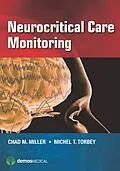"I commend the editors for their careful perspective on the current state of neuromonitoring. The individual chapters provide excellent overviews of specific neuromonitoring tools and paradigms"
-From the Foreword by J. Claude Hemphill III, MD, MAS, FNCS
While damage resulting from a primary injury to the brain or spine may be unavoidable, harm from secondary processes that cause further deterioration is not. This practical, clinical resource describes the latest strategies for monitoring the brain after acute injury. With a focus on individualization of treatment, the book examines the role of various monitoring techniques in limiting disability and potentiating patient recovery during the acute phase of brain injury. International experts in diagnosis and treatment of secondary injury explain in detail the current utilization, benefits, nuances, and risks for each commercially available monitoring device as well as approaches vital to the care of brain and spine injured patients. They cover foundational strategies for neuromonitoring implementation and analysis, including proper catheter placement, duration of monitoring, and treatment thresholds that indicate the need for clinical intervention. The book also addresses multimodality monitoring and common programmatic challenges, and offers guidance on how to set up a successful multimodal monitoring protocol in the ICU. Also included is a chapter on the key role of nurses in neuromonitoring and effective bedside training for troubleshooting and proper execution of treatment protocols. Numerous illustrations provide further illumination.
Key Features:
- Presents state-of-the-art neuromonitoring techniques and clinical protocols for assessment and treatment
- Emphasizes practical implementation for successful patient outcomes
- Written by international experts at the forefront of neurocritical care monitoring
- Provides a framework for practitioners who wish to individualize patient care with an emphasis upon the needs of the critically ill brain
- Discusses the key role of nurses in neuromonitoring and effective bedside training for management and troubleshooting of devices
Autorentext
Michel T. Torbey, MD, is Professor of Neurology and Neurosurgery and Director, Division of Cerebrovascular Diseases and Neurocritical Care, Wexner Medical Center, Ohio State University, Columbus, OH.
Inhalt
Contents
Contributors
Foreword J. Claude Hemphill III, MD, MAS, FNCS
Preface
1. Intracranial Pressure Monitoring
Nessim Amin, MBBS and Diana Greene-Chandos, MD
2. Transcranial Doppler Monitoring
Maher Saqqur, MD, MPH, FRCPC, David Zygun, MD, MSc, FRCPC,
Andrew Demchuk, MD, FRCPC and Herbert Alejandro A. Manosalva, MD
3. Continuous EEG Monitoring
Jeremy T. Ragland, MD and Jan Claassen, MD, PhD
4. Cerebral Oxygenation
Michel T. Torbey, MD and Chad M. Miller, MD
5. Brain Tissue Perfusion Monitoring
David M. Panczykowski, MD and Lori Shutter, MD
6. Cerebral Microdialysis
Chad M. Miller, MD
7. Cerebral Autoregulation
Marek Czosnyka, PhD and Enrique Carrero Cardenal, PhD
8. Neuroimaging
Latisha K. Ali, MD and David S. Liebeskind, MD
9. Evoked Potentials in Neurocritical Care
Wei Xiong, MD, Matthew Eccher, MD, MSPH and Romergryko Geocadin, MD
10. Bioinformatics for Multimodal Monitoring
J. Michael Schmidt, PhD, MSc
11. Nursing: The Essential Piece to Successful Neuromonitoring
Tess Slazinski, RN, MN, CCRN, CNRN, CCNS
12. Multimodal Monitoring: Challenges in Implementation and Clinical Utilization
Chad M. Miller, MD
Index
